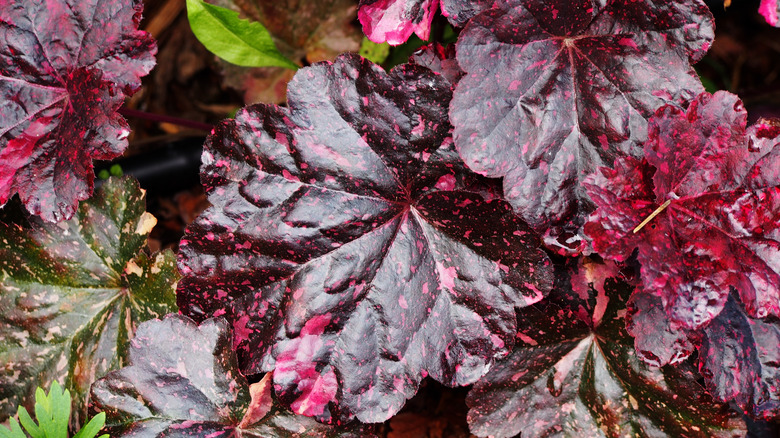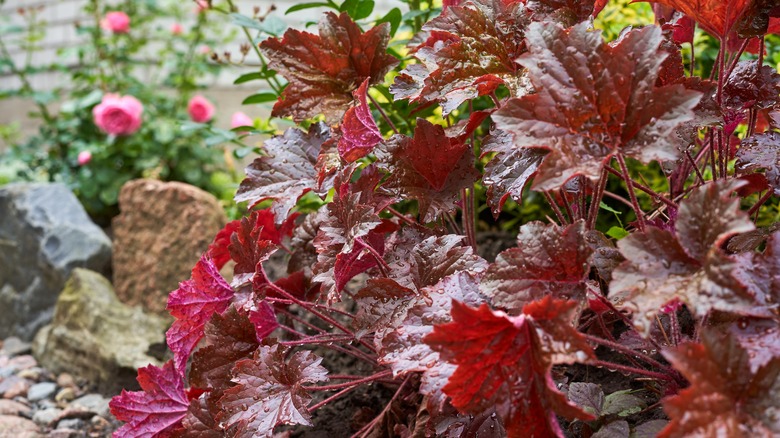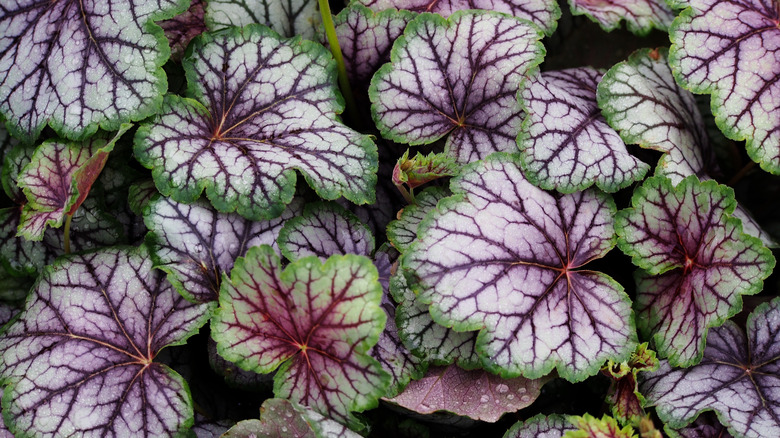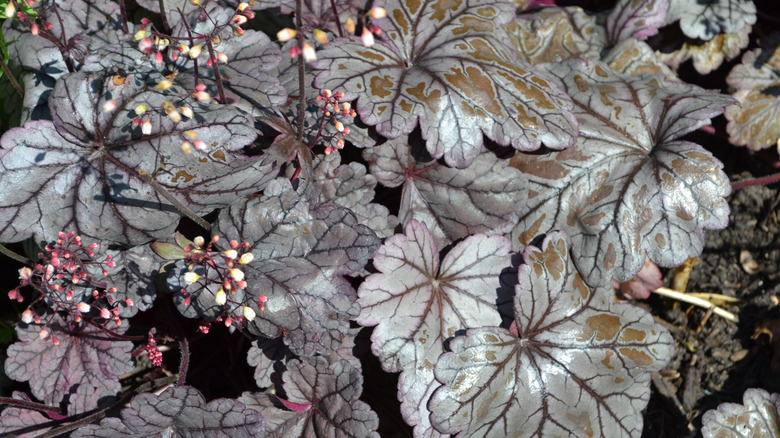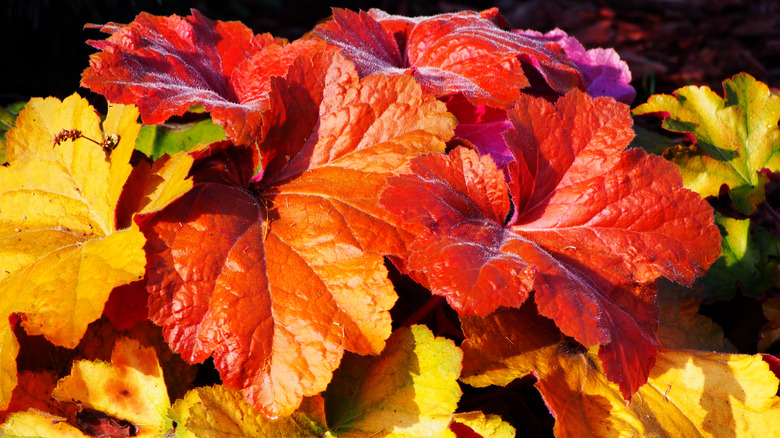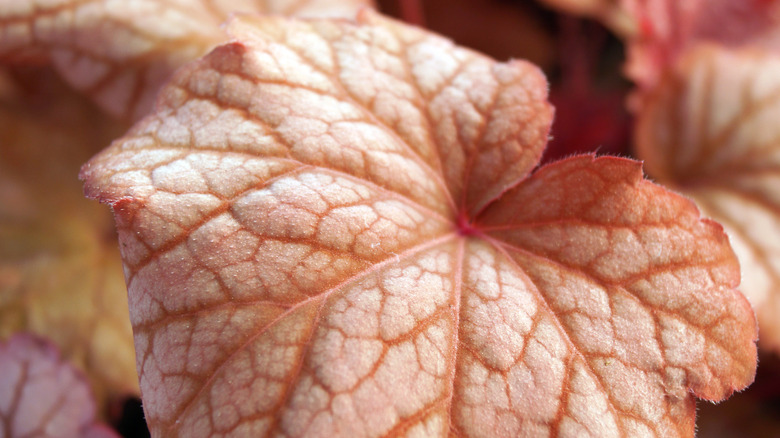How To Grow Coral Bell Flowers
We've all had doubts about how green our thumbs are from time to time, but with coral bells, you'll find a plant that's a real confidence builder. Not only is it simple to plant and practically impossible to unintentionally kill, but you'll be hard-pressed to find a more versatile plant to add color to your garden. If you have a young horticulturist in your family, you might want to consider letting them get a start with coral bells — also known interchangeably as Heuchera or alumroot. Native to North America, coral bell flowers are herbaceous shade perennials residing in the Saxifragaceae family. In the wild, they're found most often in the Southwest, Northern Mexico, Texas, and the nearby states of Arizona and New Mexico, per NC State Extension.
Coral bell flowers are vividly colorful and are, for the most part, considered evergreen. The plants regularly grow 6 to 16 inches tall with a width ranging from 2 to 36 inches. Spikes of the flower generally reach 1 to 3 feet. Leaves are distinctively large and heart-shaped. Finally, coral bell flowers can be reflective of mood, blend with the adjacent foliage, or provide whimsical splashes of color in a variety of indoor and outdoor environments.
How to use coral bell flowers in garden
You'll see cultivated coral bells in container gardens and landscape beds because they're so easy to maintain. The gardeners at Garden Smart suggest that they're also ideal for creating a color-contrasting border along a path, and do well in highlighting shady spaces. Even the largest of the plants mound to no more than a foot tall, so they don't block the view of what's behind them. And, they like company. You can complement them with hydrangeas, hostas, and begonias. They also pair well with other perennials that prefer shade, including iris, bleeding heart, and astilbe.
When deciding where to place coral bells, have some sense of how and when light hits your garden. Remember: These plants like morning sun and partial shade. A general principle: The more dark a plant's foliage is, the more tolerant of exposure to the sun it will be. So grow the lighter varieties in shadier spots. Additionally, many gardeners consider the best coral bells display to be the container, since there's no deadheading and the plants remain colorful throughout the season. Here's another place where you can mix and match, because small varieties can accompany other plants in places where their dense mounds create a filler.
Lastly, garden aficionados love the fact that butterflies and hummingbirds are attracted to the coral bells' vivid array of colorful blossoms. Because the flower is so hearty, they'll last for a while whether cut or remaining on the plant.
How to grow coral bell flowers
Because coral bells are also hybrid-friendly, you'll find they vary greatly in appearance and individually have earned such household names as magic wand, obsidian, blackberry jam, sashay, purple petticoats, walnut, and green spice. This particular genus gets its name from 18th century German doctor and instructor Johann Heinrich von Heucher.
HGTV suggests that coral bells should be planted en masse and be used in both landscaping and in garden containers. In nature, they're often found in canyons, so it's clear that they prefer partial shade, although in colder climates they've proven to withstand considerable amounts of sunshine as well.
When planting, makes sure your plants have soil that's only slightly acidic or neutral, but also moist and well-drained. (HGTV recommends soil with a pH of 6.0 to 7.0 because some species find more acidic or clay-like soils inhospitable.) The best news: Other than keeping the plants hydrated regularly in their first year, these plants do most of the work themselves.
How to care for coral bell flowers
Over the next three to five years, you'll want to divide the clumps of coral bells in order to provide more room for growth and blooms, which often last well into summer. Once the flowers have concluded their display, you can simply cut them away, which allows the plant's energies to return to leaf production. Early spring is the best time for pruning in order to provide abundant room for new growth.
The most common problem associated with caring for coral bells has to do with heat and excessive sun exposure. Generally speaking, they're fairly resistant to pests from insects to deer, and they're resilient when it comes to common diseases. But be vigilant that after a freeze and thaw, the plant's roots are not above ground. Occasional and intermittent mulching is the best preventative.
According to The Spruce, black vine weevil larvae can sometimes bore into the roots and crowns of coral bell flowers as summer turns to fall, causing affected plants to droop or wilt. The larvae will be plainly visible on coral bells and can be simply removed by hand and destroyed. Should an infestation persist, coral bells can be treated with neem oil or a mild insecticide.
Varieties of coral bell flowers
As mentioned, coral bell flowers and their accompanying leaves appear in nearly every color of the rainbow, running the gamut from silver and black to vibrant reds, greens, purples, and blue. The genus of coral bells consists of between 35 to 50 (depending on your source), and all are native to North America. Because the species so frequently interbreeds, incontrovertible taxonomy remains elusive.
Coral bells are part of the Saxifragaceae family which contains such nearby relatives as saxifraga, mukdenia, astilbe, tiarella, bergenia, astilboides and rodgersia. It's not at all unusual to see a member of this plant family growing up through sidewalk cracks and other stony spots. And their roots have been known to create those cracks, too.
Proven Winners recommends a nice assortment of coral bell flowers, although the best way to choose is to simply take an internet tour. In doing so, you'll find that florists have tried to meet nature halfway by inventing names as fanciful as the plants they're trying to describe. (The one above, for example, is called Southern Comfort, perhaps because it resembles a well-blended tipple with a twist of lemon garnish.)
One of the more inclusive lists of different varieties of alumroot/heuchera/coral bells can be found at the Lady Bird Johnson Wildflower Center, which isn't surprising since the plants are indigenous to the Texas, and the former first lady made planting flowers a keystone of her Beautify America program back in the 1960s.
How to repot coral bell flowers
Botanists at The Morning Call recommend first examining the growing conditions where you plan to plant your coral bells. (Remember they like well-draining but moist soil and shade.) Second, every three to five years, you'll want to separate the base from the smaller side crowns (with roots included) and transplant then, while keeping in mind that it's essential to plant the crown at or just above the soil line. You should also consider replanting your coral bells in their entirety, since the kind of intrusive plant surgery recommended can create stress for the plant. Their root system being shallow makes this a relatively easy task.
Another element at play is a phenomenon known as heaving, which describes how plants can push up out of the ground while temperatures fluctuate during the winter between freezing and thawing. You may find yourself digging up your plants and having to reposition them deeper in the soil. Mulch can minimize the need for this.
If growing coral bells in containers, make sure to repot them when they get too big for their current pot. Gently remove them from their old home, and place the root ball in the new container with 6 inches of space for the plant to spread out (via Plant Addicts). Add fresh soil to cover the roots, water gently, and place your container in a spot where coral bells can thrive.
